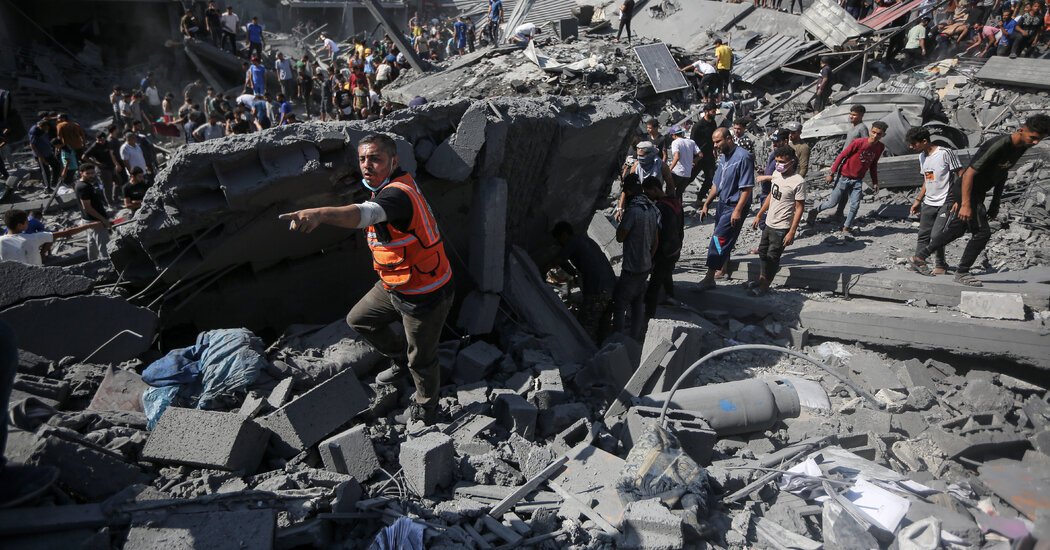
According to a new analysis published in The Lancet, deaths caused by bombs and other traumatic injuries during the first nine months of the war in Gaza may have been underestimated by more than 40%.
The peer-reviewed statistical analysis, conducted by epidemiologists at the London School of Hygiene and Tropical Medicine, used modeling in an attempt to provide an objective third-party estimate of fatalities. The United Nations relied on data from the Hamas-led Health Ministry, which it said was largely accurate, but which Israel criticizes as inflated.
But the new analysis suggests that the Hamas Ministry of Health’s tally is significantly underestimated. The researchers concluded that the death toll from Israel’s aerial bombardment and ground military operation in Gaza between October 2023 and the end of June 2024 was around 64,300, rather than the 37,900 reported by the Palestinian Ministry of Health.
The estimate in the analysis corresponds to 2.9% of the pre-war Gaza population who were killed by traumatic injuries, or one in 35 inhabitants. The analysis did not take into account other war-related victims, such as deaths from malnutrition, waterborne diseases or the collapse of the health system as the conflict progresses.
The study found that 59% of the dead were women, children and people over the age of 65. It has not been established what percentage of the reported deaths were combatants.
Mike Spagat, an expert in calculating war casualties who was not involved in this research, said the new analysis convinced him that Gaza’s casualties were undercounted.
“This is good evidence that the real number is higher, probably substantially higher, than the official Department of Health numbers, higher than I thought in recent months,” said Dr Spagat, a professor at Royal Holloway College of University of London.
But presenting precise figures, such as an underreported mortality of 41%, is less helpful, he said, since the analysis actually shows that the true total could be lower or substantially higher. “Quantitatively, it’s much more uncertain than I think the study shows,” Dr. Spagat said.
The researchers said their estimate of 64,260 deaths from traumatic injuries has a “confidence interval” of 55,298 to 78,525, meaning the actual number of fatalities is likely in that range.
If the estimated level of underreporting of deaths up to June 2024 is extrapolated up to October 2024, the total figure of casualties in Gaza in the first year of the war would exceed 70,000.
“Deaths from war wounds are important because they raise the question of whether the campaign is proportional, whether it is actually true that sufficient measures are taken to avoid civilian casualties,” said Francesco Checchi, an epidemiologist. with experience in conflicts and humanitarian crises and professor at the London School of Hygiene and Tropical Medicine, author of the study. “I think commemorating is important. There is intrinsic value in just trying to find the right number.”
The analysis uses a statistical method called capture-recapture analysis, which has been used to estimate casualties in other conflicts, including civil wars in Colombia and Sudan.
For Gaza, the researchers compiled three lists: the first is a registry maintained by the Palestinian Ministry of Health, which mainly includes deaths in hospital morgues and estimates of the number of unrecovered people buried under the rubble. The second concerns deaths reported by family members or community members through an online survey established by the ministry on January 1, 2024, when the pre-war death registration system had collapsed. It asked Palestinians inside and outside Gaza to provide the names, ages, national identity card numbers and places of death of the victims. The third source was obituaries of people who died from injuries posted on social media, which may not include all the same biographical details and which the researchers compiled manually.
The researchers analyzed these sources to look for individuals who appear on multiple lists of killed people. A high level of overlap would have suggested that few deaths had gone uncounted; the low quantity found suggested the opposite. The researchers used models to calculate the probability of each individual appearing on any of the three lists.
“The models allow us to actually estimate the number of people who were not listed at all,” Dr. Checchi said. This, combined with the given number, gave analysts the total.
Patrick Ball, director of research at the Human Rights Data Analysis Group and a statistician who has conducted similar estimates of violent deaths in conflicts in other regions, said the study is strong and well-reasoned. But he warned that the authors may have underestimated the amount of uncertainty caused by the ongoing conflict.
The authors used several variations of mathematical models in their calculations, but Dr Ball said that instead of presenting a single figure – 64,260 deaths – as an estimate, it would have been more appropriate to present the number of deaths in a range between 47,457 and 47,457. 88,332 deaths, a span that includes all the estimates produced by modeling the overlap between the three lists.
“It’s really difficult to do this kind of thing in the middle of a conflict,” Dr. Ball said. “It takes time and it takes access. I think you could say the range is wider, and that would be plausible.”
While Gaza had a strong death registration process before the war, it now has only a limited function after the destruction of much of the health system. Deaths are not counted when entire families are killed at the same time, leaving no one to report, or when an unknown number of people die in the collapse of a large building; Gazans are increasingly being buried near their homes without going through the morgue, Dr. Checchi said.
The study’s authors acknowledged that some of those believed dead may actually be missing, most likely taken prisoner in Israel.
Roni Caryn Rabin AND Lauren Leatherby contributed to the reporting.
